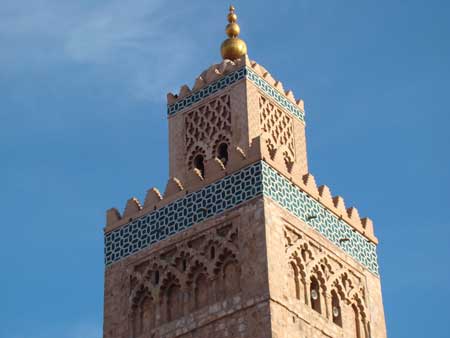Marrakesh

Marrekesh is simply uncapturable: like Venice, Borobudur, or perhaps Machu Pichu, a photograph of Marrakesh encompasses too narrow a field, words are too prosaic to really evoke a sense of the place, and both video and audio record just a slice of the experience. Marrakesh is all of these things, and more, but it's the totality that makes it such an experience for the senses.
Better then to experience it, instead of trying to capture it. But where to begin? For us it was in the dark, winding alleyways of the marvelous souks: markets of spices, carpets, leatherwork, punched tin lanterns and colored glass, backgammon boards of inlaid wood, tall candles, and traditional Moroccan slippers. But we explored around the old medina's edges and the magisterial city wall as well, where we enjoyed the carefully tended rose gardens growing at the base of the Koutubia Mosque ("the most perfect minaret in North Africa"), the storks' nests on the crenelated city walls, and the phenomenal tilework of the Bahia Palace. And evenings, after browsing the shop windows of the jewelers and cobblers we settled down for warm soup and kebabs in the outstanding Djemaa el Fna, which our guidebook called "the finest city square in the world."
It was tempting to draw parallels: the Koutoubia had been built around the time of Bologna's Due Torri, and the plaza reminded me very much of Siena. The dining experience reminded me of the fantastic meals we enjoyed in Zanzibar's Forodhani Gardens (with lamb and plums instead of shrimp and sugarcane). But in so many ways Marrakesh has no parallel, and a great deal of that refreshing individuality is due to the way Marrakesh retains its sense of tradition.
Take the souks, which burgeon with all sorts of things to make a foreigner marvel. But amid the foreign travelers were an equal if not greater number of Moroccans doing their shopping for the week. Same goes for the Madersa Ben Youssef, whose ascetic Islamic architecture made it a natural photographic target but which was equally a modern and functioning Islamic school, and classes were in session! Lastly, the Djemaa el Fna, the attraction most vulnerable to becoming a sort of Disneyland for travelers bent on entertainment, remained unadulterated. The jugglers and acrobats performed for a crowd where the foreigners were a distinct minority, and as we sipped our soup we were the only ones at the table whose first language was not Arabic.
Marrakesh's appeal, then, is that it is unpretentious, and while it certainly does attract travelers it is engaging because it has always been, exciting because of what it is rather than what it intends to be, and a delight for the senses not because that's what brings in the tourists but because that's the result of what's for sale in the souks. Perfect: travel is best in places that don't distort themselves to suit the whims of foreigners.
Picture courtesy of friend and photographer Hugo Tilborg, who traveled through Marrakesh in late December 07.
Trackbacks
The author does not allow comments to this entry


Comments
Display comments as Linear | Threaded